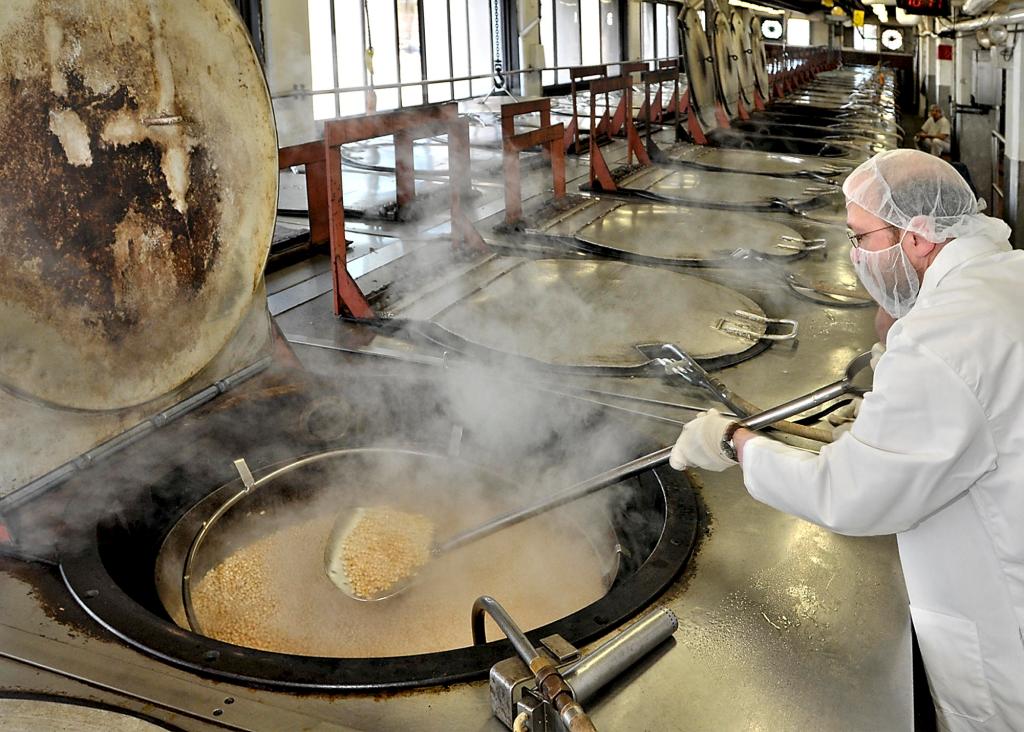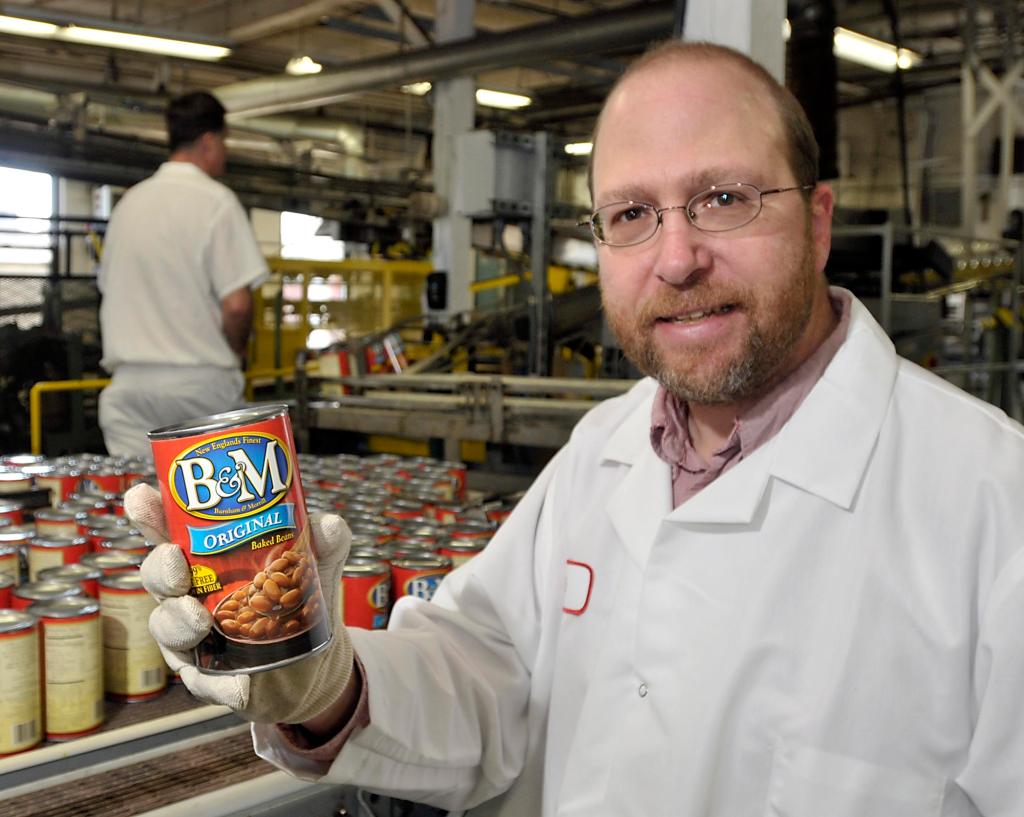PORTLAND — When Conrad Lausier first uttered the words “watch yourself” to me, I thought he was being a little overly cautious.
I mean, he was taking me through the B&M Baked Beans factory on the edge of Casco Bay in Portland. How dangerous could baking beans be?
But within minutes, I saw a 900-pound bean pot, full of freshly baked beans, flying toward me. Literally.
At B&M, the bean pots are suspended and move around the factory on a system of overhead rails and pulleys. Some pots hang only a few feet off the floor, while others are head high, depending on where they are going.
At one point, I was standing a little too close to where the bean pots get tugged from one of the 75 or so brick ovens to a long draining trough. But I heard Lausier’s “watch yourself” again, and quickly stepped out of the way.
“You’ve got to be careful, things move pretty fast up here,” said Lausier, 56, of North Yarmouth, who has been a baker at B&M for 38 years. “But it’s organized; everybody knows what they’re doing.”
Everybody but me.
The B&M plant, a Portland landmark that’s visible from Interstate 295 in the city’s eastern end, is a five-story brick factory built in 1913. The business itself, Burnham & Morrill Co., began in 1867.
The factory has a classic, old-fashioned look on the outside, but I was fairly surprised to find the inside old-fashioned and decidedly low-tech as well.
The bean pots are made of dark steel, and workers suspend them with giant chains and hooks. At various points, large steel harnesses are used to support the pots.
Some of the rail systems have electricity, so a worker can push a control wired to the rail and move the pot back and forth or up and down. But on other sections of the rails, workers tug or shove the giant pots to where they are supposed to go.
The ovens are lined up side by side, in two rows. The older ones are brick inside and out. Some of the newer ones are metal on the outside and brick on the inside. All have giant metal lids that have to be lifted off with a hook and chain attached to the overhead rail system.
Before entering the baking area, I had to put on a hair net, though I have very little hair. I also had to put on a beard net, which I didn’t know existed.
As Lausier showed me the basics of the baker’s job, I realized it was all about movement. A sort of bean ballet.
The baker gets a pot of beans that have been blanched and “sauced” with molasses, sugar, mustard and other ingredients. Lausier had me grab a push-button control attached by a cord to the overhead railing and guide one of the pots down the row of ovens, past maybe 20 of them, until we found an open one.
After lowering the pot into the steaming-hot oven (450 degrees), I climbed up on a moving step stool – it glides on a railing attached to the fronts of the ovens – and lowered the pot into it. Then I grabbed a shovel-sized stirring implement and began to stir.
Another baker, John Hansen, showed me the proper technique, facing the back of the shovel down into the pot and lodging the handle against the opening of the oven for leverage.
“Just go halfway down and turn the beans over a couple times, then put it all the way at the bottom and bring some beans forward,” said Hansen, a 36-year baker. “Then level them off a little.”
Lausier showed me how to put a water regulator – a metal spigot attached to a hose – on the lip of the oven. Then I lowered the giant lid – maybe 4 feet in diameter – onto the top of the oven and moved it around until it fit perfectly.
After I was done, I felt a stinging sensation on my wrist. I looked down and saw a 1-inch burn mark.
“It’s hot there, better watch yourself,” said Lausier, after he saw that I had leaned onto the oven’s top a little too far.
Then, as my baker mentors taught me, I grabbed onto a railing near the ovens and pulled myself and my rolling foot stool about 5 or 6 feet to the next oven.
There, I took off the lid (I was wearing gloves), stirred, replaced the lid and water regulator and didn’t burn myself. I did a couple more stirring sessions on my moving foot stool before taking a break.
Each pot of beans bakes for about three hours or more. That’s something everyone at B&M is very proud of. They made a point of telling me that some of their competitors merely blanch their beans in water or steam them, though they call their product “baked.”
At B&M, after the beans are baked, the pots are drained and cooled. Then the pots are hoisted over a stainless-steel trough and dumped. There’s a hole in the trough, and the beans slowly drain to the floor below, where the canning process begins.
The beans will be put in cans, get more sauce, then be topped and put in a pressure cooker so they can keep on shelves. Then they’ll be cooled, labeled and ready for delivery.
The whole process at B&M works on gravity, with the baking on the top floor and everything else done on lower floors. The labeling and packaging is down on the first floor.
My last task of the morning was to simply swing 900 pounds of beans and pot up on its side and hook it in place, so the beans would drop out to begin their journey to the cans. I basically had to put my whole body into it, but eventually I got it in place.
Later, during a break, Lausier told me that the best part of his job is the “satisfaction” he gets in baking beans that he feels are better than anything else on the market.
Staff Writer Ray Routhier can be contacted at 791-6454 or at:
rrouthier@pressherald.com
Send questions/comments to the editors.





Comments are no longer available on this story